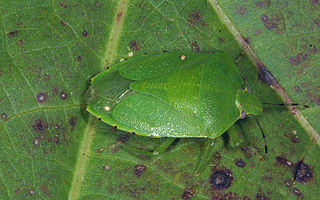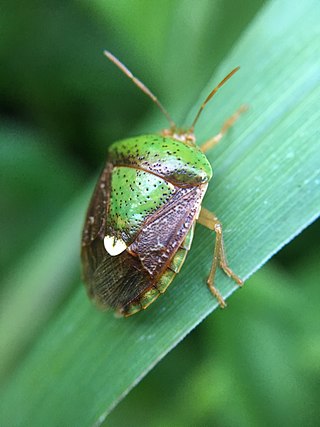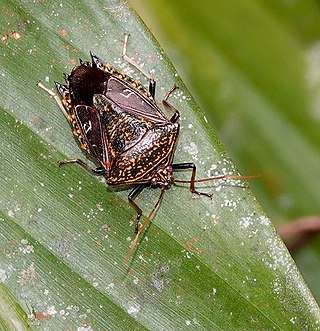
The Pentatomoidea are a superfamily of insects in the Heteroptera suborder of the Hemiptera order. As Hemiptera, they share a common arrangement of sucking mouthparts. The roughly 7000 species under Pentatomoidea are divided into 21 families. Among these are the stink bugs and shield bugs, jewel bugs, giant shield bugs, and burrower bugs.

Pentatomidae is a family of insects belonging to the order Hemiptera, generally called shield bugs or stink bugs. Pentatomidae is the largest family in the superfamily Pentatomoidea, and contains around 900 genera and over 4700 species. As hemipterans, the pentatomids have piercing sucking mouthparts, and most are phytophagous, including several species which are severe pests on agricultural crops. However, some species, particularly in the subfamily Asopinae, are predatory and may be considered beneficial.

Acanthosomatidae is a family of Hemiptera, commonly named "shield bugs" or "stink bugs". Kumar in his 1974 world revision recognized 47 genera; now this number is 55 genera, with about 200 species, and it is one of the least diverse families within Pentatomoidea. The Acanthosomatidae species are found throughout the world, being most abundant in high-latitude temperate regions and in subtropical regions at high altitudes.

The green stink bug or green soldier bug is a stink bug of the family Pentatomidae.

The brown marmorated stink bug is an insect in the family Pentatomidae, native to China, Japan, Korea, and other Asian regions. In September 1998, it was collected in Allentown, Pennsylvania, where it is believed to have been accidentally introduced. The nymphs and adults of the brown marmorated stink bug feed on over 100 species of plants, including many agricultural crops, and by 2010–11 had become a season-long pest in orchards in the Eastern United States. In 2010, in the Mid-Atlantic United States, $37 million in apple crops were lost, and some stone fruit growers lost more than 90% of their crops. Since the 2010s, the bug has spread to the nation of Georgia and Turkey and caused extensive damage to hazelnut production. It is now established in many parts of North America, and has recently become established in Europe and South America.

Cosmopepla lintneriana, the twice-stabbed stink bug, is a species of insect in the family Pentatomidae. Cosmopepla lintneriana was first described in 1798 by Johan Christian Fabricius as Cimex carnifex, and then again in 1865 by Thomas Say as Cosmopepla bimaculata. Cosmopepla lintneriana is hosted by a variety of plants, including milk thistle, echinacea, asparagus, oats, mint and goldenrod, and is widespread throughout North America, from Canada to Mexico. Adult C. lintneriana are black with a red, orange, or yellow band across the pronotum and a short red stripe along the midline, and two red spots at the apex of the scutellum. Nymph coloration ranges from red to white with black markings that change as they grow.

Edessa is a large New World genus of stink bugs in the family Pentatomidae, containing over 250 described species. Several other genera used to be included until recently, such as Pygoda, Ascra, Paraedessa, Doesburgedessa and others.

Piezodorus guildinii, known generally as red-banded stink bug, is a species of stink bug in the family Pentatomidae. Other common names include the small green stink bug and alfalfa bug.

Edessa florida is a species of stink bug in the family Pentatomidae. It is found in North America.

Edessa bifida is a species of stink bug in the family Pentatomidae. It is found in the Caribbean, Central America, North America, and South America. Some have proposed elevating the preexisting subgenus Ascra to genus status, thereby reclassifying E. bifida as Ascra bifida.

Proxys punctulatus, the black stink bug, is a species of stink bug in the family Pentatomidae. It is found in the Caribbean Sea, Central America, and North America.
Edessa virididorsata is a species of stink bug within the family Pentatomidae. It is found in Colombia, Venezuela, Guyana, Surinam, French Guiana, Brazil, Paraguay, and Argentina.

Pygoda is a New World genus of stink bugs in the family Pentatomidae. It was formerly considered a subgenus of Edessa but was elevated to genus based on morphological traits: species grouped under Pygoda share a distinctive set of features from body, male external genitalia, and male and female internal genitalia that are very different from any other subgenus of Edessa.

Pygoda polita is a species of stink bug in the family Pentatomidae found in South America. It was first described as Pentatoma polita by Lepeletier and Serville in 1825, included under genus Edessa in 1851, and subsequently renamed under genus Pygoda in 2018.

Pygoda poecila is a species of stink bug in the family Pentatomidae. It was first described in 2018 and is found in Central America. Its scientific name is in reference to the mottled body.
Pygoda variegata is a species of stink bug in the family Pentatomidae. It was first described in 2018 and is found in Costa Rica and Panamá. Its scientific name is in reference to the mix of brown, green and yellow of the body.
Pygoda irrorata is a species of stink bug in the family Pentatomidae found in South America. It was first described as Edessa irrorata by William Dallas in 1851 and renamed under genus Pygoda in 2018.
Pygoda civilis is a species of stink bug in the family Pentatomidae found in Ecuador. It was first described as Edessa civilis by Gustav Breddin in 1903 and renamed under genus Pygoda in 2018.
Pygoda thoracica is a species of stink bug in the family Pentatomidae found in Ecuador. It was first described as Edessa thoracica by William Dallas in 1851 and renamed under genus Pygoda in 2018.
Pygoda expolita is a species of stink bug in the family Pentatomidae found in Costa Rica and Panamá. It was first described as Edessa expolita by William Lucas Distant in 1892 and renamed under genus Pygoda in 2018.














